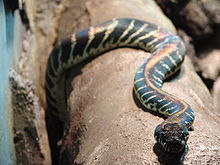- Morelia boeleni
-
Morelia boeleni 
Scientific classification Kingdom: Animalia Phylum: Chordata Subphylum: Vertebrata Class: Reptilia Order: Squamata Suborder: Serpentes Family: Pythonidae Genus: Morelia Species: M. boeleni Binomial name Morelia boeleni
(Brongersma, 1953)Synonyms - Liasis boeleni - Brongersma, 1953
- Liasis taronga - Worrell, 1958
- Liasis boeleni - Stimson, 1969
- Python boeleni - McDowell, 1975
- Morelia boeleni - Underwood & Stimson, 1990[1]
- Common names: Boelen's python.[2]
Morelia boeleni is a non-venomous python species found in the mountains of New Guinea.[2] No subspecies are currently recognized.[3]
Contents
Description
The upperside color pattern is dark bluish-black or purplish-black and the anterior part of underside white to pale yellow. The white extends up the flanks as a series of streaks. The upper and lower lips are also patterned with pale or whitish labial scales. The black portions are commonly iridescent with an oil-slick like sheen. The body is stocky and the head large.
Geographic range
The unmistakable and famed Boelen's Python is Papua New Guinea's most important[citation needed] snake species, receiving the highest legal protection possible. Locally it is also known as the Blu Moran or Papa Graun. Found in Indonesia (Western New Guinea in the Wissel Lakes region) and Papua New Guinea (the provinces of Eastern Highlands, Central and Morobe, and Goodenough Island). The type locality given is "Dimija (3°56'S, 136°18'E), Wissel Lakes, Dutch New Guinea, about 1750 m (5700 ft) above sea level" (Western New Guinea, Indonesia).[1]
Habitat
The species inhabits forested montane regions of over 1000 metres elevation. It is generally encountered on the forest floor, but is also reckoned to be an able climber.
Diet
The diet consists of mammals, lizards, and birds.
Captivity
This species is considered to be highly desirable by private keepers due to its beauty, but is also exceptionally rare in collections[4]. Although captive-born snakes are fairly hardy in captivity[5], wild-caught individuals are considerably more difficult to keep successfully[6]. Captive breeding is exceedingly rare, and the conditions necessary are still unclear[7].
See also
- List of pythonid species and subspecies.
- Pythonidae by common name.
- Pythonidae by taxonomic synonyms.
References
- ^ a b McDiarmid RW, Campbell JA, Touré T. 1999. Snake Species of the World: A Taxonomic and Geographic Reference, vol. 1. Herpetologists' League. 511 pp. ISBN 1-893777-00-6 (series). ISBN 1-893777-01-4 (volume).
- ^ a b Mehrtens JM. 1987. Living Snakes of the World in Color. New York: Sterling Publishers. 480 pp. ISBN 0-8069-6460-X.
- ^ "Morelia boeleni". Integrated Taxonomic Information System. http://www.itis.gov/servlet/SingleRpt/SingleRpt?search_topic=TSN&search_value=634776. Retrieved 18 September 2007.
- ^ http://www.boelenspythons.com/home.html
- ^ http://www.boelenspythons.com/captivemanagement/hatchlingssubadults.html
- ^ http://www.boelenspythons.com/captivemanagement/wildcaughts.html
- ^ http://www.boelenspythons.com/reproduction/index.html
External links
- Morelia boeleni at the Reptarium.cz Reptile Database. Accessed 18 September 2007.
Categories:- Morelia
- Reptiles of New Guinea
Wikimedia Foundation. 2010.
